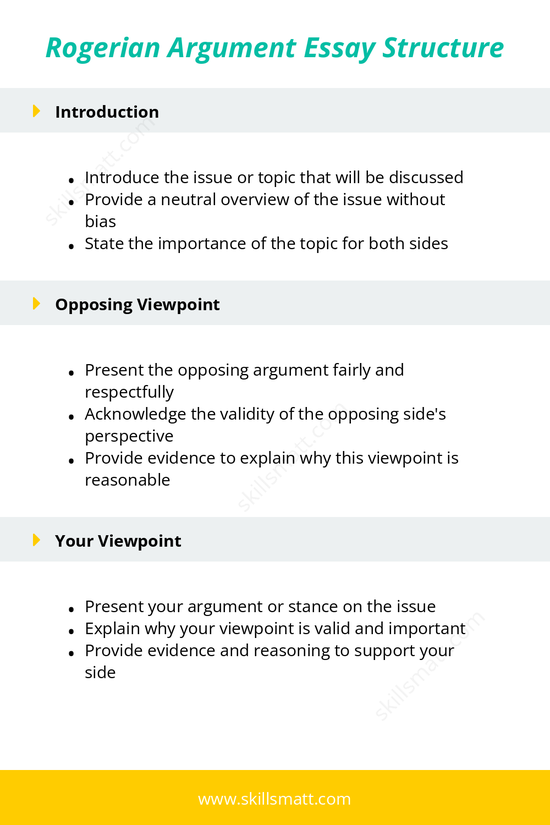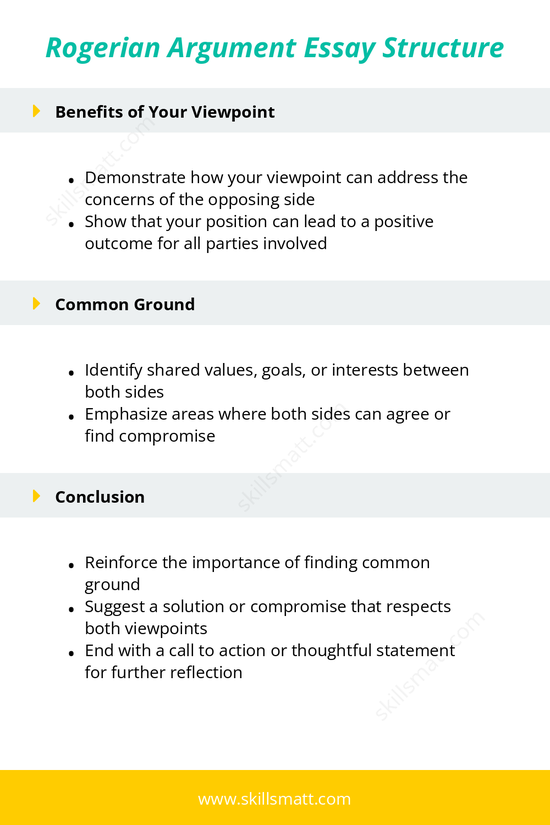In today’s increasingly polarized world, finding common ground on controversial issues is more important than ever. The Rogerian Argument Essay Structure offers a thoughtful approach to resolving conflicts by promoting mutual understanding between opposing viewpoints. This essay structure encourages dialogue and aims for a solution that satisfies both sides. Below is an outline of how to construct a Rogerian Argument Essay, which can be applied to a wide range of debates or issues.
Introduction
The introduction of a Rogerian Argument Essay sets the stage for a balanced discussion. The goal is to present the issue or topic in a neutral manner, allowing for a fair exploration of both perspectives.
- Introduce the issue or topic that will be discussed: Begin by providing an overview of the issue at hand. It’s essential to present the topic in a way that invites both sides to engage in the discussion.
- Provide a neutral overview of the issue without bias: Avoid taking sides in the introduction. Instead, offer an unbiased explanation of the topic, acknowledging that both perspectives have merit.
- State the importance of the topic for both sides: Highlight the significance of the issue for both sides involved, showing why it matters to everyone and not just one group.
Opposing Viewpoint
In this section, the Rogerian approach emphasizes fairness and respect toward the opposing viewpoint. By acknowledging the legitimacy of the other side’s perspective, you demonstrate open-mindedness and foster constructive dialogue.
- Present the opposing argument fairly and respectfully: Present the opposing side’s argument in its strongest form. Avoid misrepresentation or oversimplification. This shows respect for the opposing view and creates a foundation for mutual understanding.
- Acknowledge the validity of the opposing side’s perspective: Recognize that the opposing viewpoint has legitimate concerns. This not only strengthens the argument but also creates a space for meaningful conversation.
- Provide evidence to explain why this viewpoint is reasonable: Offer evidence that supports the opposing argument, demonstrating that it is a reasonable perspective to consider.
Your Viewpoint
After addressing the opposing viewpoint, it is time to present your argument. The Rogerian approach encourages presenting your side as a valid and well-supported position without attacking the other side.
- Present your argument or stance on the issue: Clearly state your position on the issue. Explain why your viewpoint is important and worthy of consideration.
- Explain why your viewpoint is valid and important: Use logic, reason, and evidence to support your stance. Show the reader that your perspective is grounded in reality and has merit.
- Provide evidence and reasoning to support your side: Include facts, data, examples, or expert opinions that back up your argument. This adds credibility to your viewpoint.
Benefits of Your Viewpoint
One of the key elements of the Rogerian Argument is showing how your viewpoint can lead to a positive outcome for everyone involved. This helps to avoid a confrontational tone and focuses on common benefits.
- Demonstrate how your viewpoint can address the concerns of the opposing side: Show that your argument is not only valid but also considerate of the other side’s concerns. This emphasizes the cooperative nature of your argument.
- Show that your position can lead to a positive outcome for all parties involved: By explaining how your viewpoint can resolve the issue in a way that benefits everyone, you create a sense of compromise and mutual gain.
Common Ground
Identifying shared values, goals, or interests is an essential step in the Rogerian model. This helps to shift the focus from differences to similarities, creating a pathway to a potential solution.
- Identify shared values, goals, or interests between both sides: Look for areas of agreement where both parties can unite. Whether it’s a common goal, value, or need, highlighting these connections can lead to greater cooperation.
- Emphasize areas where both sides can agree or find compromise: Emphasize the potential for compromise. Point out solutions or approaches that both parties can support, facilitating a more constructive conversation.
Conclusion
The conclusion of a Rogerian Argument Essay is not about “winning” but about reinforcing the importance of compromise and finding common ground. It provides a thoughtful closing statement that encourages continued dialogue and reflection.
- Reinforce the importance of finding common ground: Emphasize that despite differences, finding a common ground benefits all parties and helps in resolving conflicts peacefully.
- Suggest a solution or compromise that respects both viewpoints: Propose a solution that acknowledges the concerns of both sides. This solution should be practical, balanced, and focused on cooperation.
- End with a call to action or thoughtful statement for further reflection: Close with a statement that encourages the reader to think critically about the issue and the possibility for constructive dialogue moving forward.
The Rogerian Argument Essay Structure is an effective way to approach contentious issues with empathy and respect. By presenting both sides fairly and demonstrating the benefits of compromise, you can foster understanding and cooperation, making it an invaluable tool for resolving conflicts in writing and beyond.


